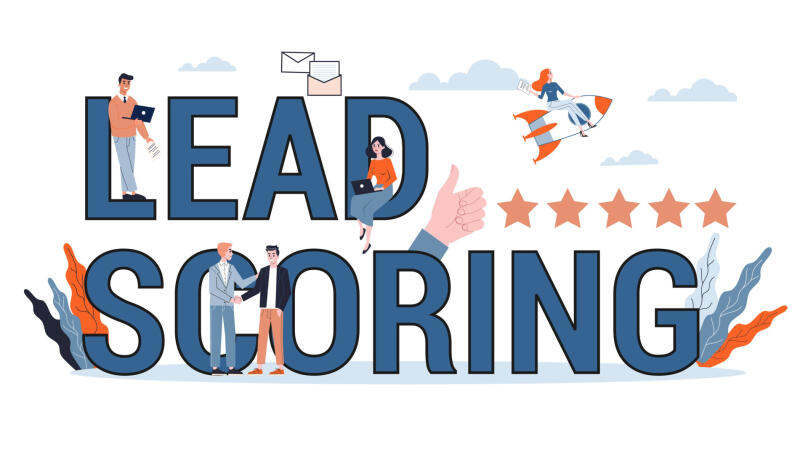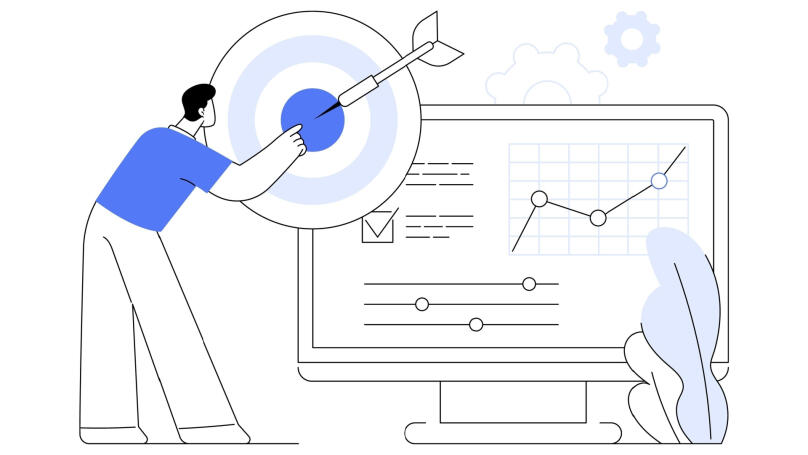Lead scoring

What is lead scoring?
Lead scoring is the assignment of values or points to the leads generated for your business, by which these leads can be characterized, described, or measured. The definition of a lead encompasses a potential client, an existing client, a site visitor, or an email newsletter subscriber. In short, any group of people who interact with your business. The sales team primarily uses their evaluation to adjust marketing, allocate resources, and prioritize customers, as each requires a unique approach, speed, and tools. The assessment can be made up of entirely different factors and attributes, such as, for example, subscribing to you, visiting the site, commenting on the company's social networks, possessing certain characteristics, etc.
Thus, lead scoring is one of the areas of data analysis that allows you to compare leads with each other and optimize internal business processes. Also, each business has its lead scoring system, designed with the company's goals and values in mind, so each scoring system will differ based on the business model. Typically, a score is assigned on a 100-point scale, with 0 being the lowest and 100 being the highest.
Why is lead scoring important
Whichever way leads are scored, it shows one thing - the likelihood that they will purchase from you. The higher the score, the higher the probability. For example, the lead scoring methodology used for calculating customer points allows you to:
-
Weed out insufficiently warmed-up and unprepared leads. So, Rather than spreading your budget thin across all of them, you can concentrate on leads closest to the purchase;
-
Save time by focusing on those groups that will be converted into buyers;
-
Reduce marketing and customer acquisition costs. For example, according to Outfunnel, InBeat saved 40% of its marketing budget thanks to lead scoring.
-
Improve customer service and customer satisfaction. For example, a business may pay more attention to customer service with a higher score because it indicates their importance. A business can develop special offers, promotions, and promo codes for customers with a high rating;
-
Increase conversion rates while reducing all other resource costs. Additionally, it will establish a line between departments in your business and allow you to distribute workloads and tasks better. For example, if your business has sales reps complaining that marketing directs them to "difficult clients" that take a long time to process, then a lead scoring system can fix it. With its help, leads will be redirected to representatives only if they score 50 points or higher, for example.
As a result of all the benefits of lead scoring, the total sales volume and the number of deals increase as well. On average, according to Eloqua research, lead scoring boosts the former by 18% and the latter by as much as 30%.
Lead scoring models

Each lead scoring model differs only in the criteria and information used to set and calculate scores. All of them are guided by the principle of relevance of leads to your target audience. Simply put, what criteria do you use to determine your target audience? A similar set of criteria will be used when estimating scores.
To calculate lead scoring, you can use the following types of information selectively:
1. Demographic Information
It is essential to consider this information when evaluating if the target audience's demographics are critical to your company. For example, if you specialize in goods for children and pregnant women or produce equipment used only in mechanical engineering, IT, or medicine. The same applies to delivering goods only in a specific city or region. In this case, points are awarded to leads for being in the region you want or being a parent/IT specialist/medic, etc. If the lead does not meet the needed characteristics, the points are deducted (which reduces its importance accordingly).
You can also award points to leads if they fill out a template or a contact form on your website, for example, as this also signals that they are ready to buy, even if they are outside your demographic range.
2. Company Information
This information should be considered in the lead scoring process if you work in the B2B sector. Indeed, you are interested in collaborating with a particular industry or organization size. Let's say you're more interested in B2C organizations. Since these are the companies you want to work with, you add points to B2C companies and subtract points from others.
3. Online Behavior
The way a prospect interacts with your website can also tell you a lot about their needs and how determined they are to buy from you. For example, which tabs and offers did the user navigate? Did they look at the photos? Did they click on banners? Have they visited it before? If, for example, this is their third visit, they are interested in your product so that you can close the deal.
It's also important to consider the number and types of pages visited, as they have different values. For example, if a user views a page with the cost of your services, it adds more points to them than viewing a page with the history or articles of the company. Likewise, those leads who view your site ten times a day rather than just once should have more points. You can also consider their time on it, but with caution: perhaps the user just forgot to close the tab.
4. Email Engagement
You can separately evaluate leads subscribed to your newsletter. For example, did they sign up voluntarily or accidentally when filling out a contact form? Also, do leads click on the links and offers you send them? Do your emails get opened often? How often do they get viewed? Points must also be awarded for each of these actions. By doing so, your marketing department will be able to determine which subject lines and email headlines are more appealing and focus on the most interested group.
5. Social Engagement
You should also consider how your potential customers interact with your social media accounts. How involved are they in the life of the brand? How many times do they comment, like, repost? Do you click the links you leave in your posts? You can also earn points if the same lead interacts with you on both Facebook and Twitter simultaneously, indicating they are particularly interested in you. The lead can also receive points if they have a lot of followers, which will make them a more valuable customer (for example, if they can recommend you to a wide range of acquaintances or are a media personality/influence).
6. Spam activity
This is the only type of information used to subtract points rather than award them. It's simple: you "minus" those leads who fill out your contact forms with "left" characters to "shoot back," leave spam messages under your posts, do not read your newsletters at all, or respond to your forms, but do not pick up the phone, do not answer, etc. Those leads should be marked as "spam" and omitted from client ratings.
Keep this in mind! You decide for yourself the number of points to add or subtract for each of the criteria. Still, it is generally accepted that the maximum score is 100, and a lead above 50 is considered suitable for further analysis.
Lead scoring best practices

All lead scoring systems, despite their differences, are used similarly. Here are some step tips to maximize their effectiveness.
1. Leverage additional valuation models
As mentioned earlier, all lead scoring methodologies aim to assess the likelihood of making a purchase. However, you can still use such a system as a base and shape it into what you need to understand certain aspects of your target audience better. After all, there are no strict rules in lead scoring, and it is possible and necessary to go beyond the limits since all the tools work best together.
Classic lead scoring models, for example, can be used to identify:
-
Potential customers with the highest (or, conversely, lowest) spending. For example, if one customer looks mainly at pages with cars and another with car accessories, it is worth focusing on the first customer since, with them, you are more likely to get serious sales;
-
Customers to whom you can sell more expensive products or plans. If, for example, a lead rushes between a page with a product for $150 and with a product for $80, it means that they are considering both options, and you can steer them toward a more expensive product;
-
Leads that are best suited to promote a brand or affiliate program. We've already mentioned leads on social media with many followers - these can be your potential ambassadors.
This principle can also be applied to identify potential cross-sell customers (buying additional items to the main product) or detect those who have already left you but returned. The latter would allow you to develop a more compelling customer retention strategy. You can also use rating systems to find weaknesses in your business. For example, customers contacting customer service repeatedly means there is a product quality problem exists.
Thus, the scope of application of lead scoring as an approach is unlimited. The changes will affect only metrics important for accounting in a particular case. Other than that, everything revolves around assigning and calculating points.
2. Include a negative rating
The higher a lead's score, the more likely they are to become your customer, and they should be given higher priority on your customer list. This is how you evaluate qualified leads. But what about the unqualified leads? Typically, they live outside of your delivery area, work in a different industry that your business can work with, or have stopped interacting with your company.
Simply ignoring them is an undesirable approach, as this way, they end up in your database anyway and create unnecessary information noise. Creating a separate lead scoring matrix is best to identify leads that are categorically unsuitable for your business or include negative points in the measurement. That is when they will be subtracted from the assessment, not just accrued, and be able to go below zero. In this case, leads with a score of -50, for example, can be safely excluded from the database and try to involve or return those whose score is still not so low.
However, you need an individual approach to working with negative ratings. For example, if the client received a "minus" only because they unsubscribed from the mailing list, it is still possible for you to work with them, but if they moved abroad, you cannot. Accordingly, it is best to manually analyze or at least check negative lead ratings and reasons to avoid disqualifying potential customers.
3. Enter "expiration dates"
What about potential customers who have changed their behavior over time? After all, customers cannot always be in the same status; just like everything else in this world, they also have a life cycle. For example, a month ago, the lead was actively reading your newsletter, and now they don't even open the email. Or a lead regularly bought toothbrush attachments but stopped visiting your website altogether. This is why it is necessary to constantly adjust the customer's assessment - to take points away for the lack of interaction or committing negative actions (such as unsubscribing) and award them for increasing their interactions with you or adding value through specific valuable actions.
How often you update your lead data and how soon you exclude them from the database when you reach a score of 0 or minus depends on your standard sales cycle. For some businesses, it is acceptable if the client is inactive for six months (if, for example, we are talking about large and long-term purchases), and some companies must conduct an audit every 10 days. The easiest way is to automate lead scoring by specifying the period in the service settings used.
Tools and software for lead scoring

For lead scoring, you can use both standard programs for collecting user data, such as Google Analytics and specialized software (Saas), which includes:
-
Lead Pilot. It's a platform with integration features that works quite simply: each lead is assigned a score from 1 to 100 based on the parameters you capture and specify. Moreover, the assessment is updated independently in case of changes; that is, monitoring takes place 24/7 in real-time. The algorithm considers customer interactions with content, actions taken, time spent on them, etc. Assessment and tracking are automated via AI, allowing lead scoring to be completely automated.
-
MadKudu. This platform is designed primarily for predictive lead scoring and companies specializing in B2B. With its help, you can identify the most likely leads and the most appropriate offers for them, i.e., correlate marketing efforts with target groups. Lead scoring analysis is also done in real-time.
-
Outfunnel. This tool combines your sales and marketing data with customer data and prioritizes customer lists. Leads' actions are automatically logged, from opening emails to visiting your website. This information can be used to identify users' interests and formats that work best for them.
-
HubSpot. This service uses data science and machine learning approaches to sort and analyze information, thanks to which it independently identifies the best leads, saving you time and eliminating the need to analyze the ratings yourself. HubSpot also offers its own CRM, making it one of the most popular lead-generation tools.
-
Drift. A platform powered by artificial intelligence that recognizes website visitors' intentions, needs, and goals. It also automatically triggers the sales funnel by engaging leads with customizable chats and other tools. All data, such as demographics, links used, preferences, past purchases, etc., can be analyzed automatically and converted for targeting.
Lead scoring examples
Let's look at an example of what the scoring system for an e-commerce company will look like. The criteria and the accrual of points for them may look like this:
-
adding products to the cart (without making a purchase) - 25 points;
-
filling out the feedback form in exchange for a discount - 10 points;
-
checking out the prices - 7 points;
-
reading blog posts - 3 points;
-
visiting the "About us" page - 1 point;
-
subscription to the company's social networks - 5 points.
For a business specializing in the sale of IT services in the B2B sector, the evaluation system can be as follows:
-
a company with a staff of up to 20 people - 10 points;
-
a company with a staff of 20 to 100 people - 15 points;
-
a company with more than 100 employees - 20 points;
-
filling out the form by a top manager - 10 points;
-
completion of the form by an intern - 5 points;
-
contacted personally by the CEO of the company - 25 points.
These calculations, based on the assessment results, allow you to structure all leads, for example, as follows:
-
new potential customers - the number of points <25;
-
warm leads - 25-50 points;
-
qualified leads: 50-75 points
-
qualified leads that are ready to sell - >75 points.
Based on the segmentation performed, you can develop new marketing and sales solutions for these groups, which will help increase their valuation and drive them closer to making a purchase.
Conclusions
Marketing often accounts for more than half of a company's revenue since finding and attracting potential customers is one of the most resource-intensive and complex processes. Lead scoring, on the other hand, offers optimization, increasing the number of closed deals while reducing costs (including time). Additionally, it minimizes the possibility of making a mistake with a marketing campaign's positioning. Lead scoring automation streamlines the sales department's work and reduces its workload. Due to its natural flexibility, the lead scoring strategy can also be applied to different types of segmentation and goals, adapting it to the needs of your specific business.























